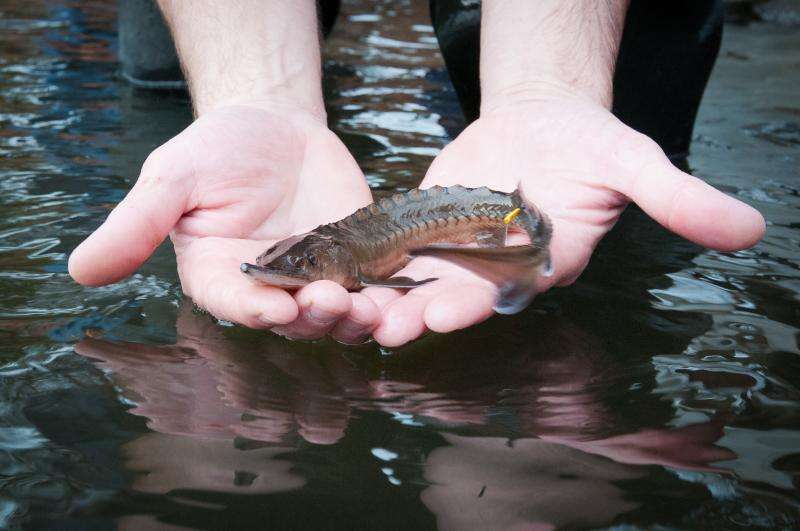European sturgeon research network established to boost prehistoric giants

Sturgeons are among the most threatened fish species worldwide. To ensure that one day these living fossils will return to our rivers in large numbers, scientists have joined forces in a Europe-wide network. Seven partner institutions collaborate on research related to the conservation and development of stable sturgeon stocks and therefore pool their resources. In order to discuss a common strategy they all come together in Neu Wulmstorf on May 13th, 2015. The network has been initiated by the World Sturgeon Conservation Society (WSCS) and the Leibniz-Institute of Freshwater Ecology and Inland Fisheries (IGB) in Berlin, a pioneer of the sturgeon reintroduction program for almost 20 years.
Sturgeons migrate between worlds: They spawn in freshwater and spend the major part of their lives – which can last more than hundred years – in the sea. Spawning and nursing requirements bring them back to swiftly running rivers with gravel sediments. After reproduction, the adults return from the rivers to marine waters almost immediately. This migratory pattern repeats in cycles of 2-5 years. But the journey of the sturgeons has become increasingly challenging: The largest river fish of the northern latitudes is stopped by barrages and waterway constructions preventing the fish from reaching their spawning habitats. In addition, pollution adversely affects the development of their offspring in many rivers. This and unsustainable harvest practices lead toward the extinction of these giants on the European continent.
Transnational collaboration to prevent the extinction of the sturgeons
Rivers, coasts and sturgeons do not stop at national borders. "The mobility of these animals makes a cross-border approach essential for effectively restoring the sturgeons. And this approach can only be successful if we closely coordinate our efforts", said Dr. Jörn Gessner, project coordinator at IGB. In order to better integrate and harmonize research and measures taken in different countries, scientists have established the European Sturgeon Research Network (ESRN). Their objective is to pave the way for further co-operations, to stimulate joint research, to better utilize existing knowledge, and to support regional networks.
As a start, a Memorandum of Understanding was signed by the World Sturgeon Conservation Society (WSCS), the IGB Berlin and the University of South Bohemia České Budějovice. Meanwhile, the Danube Delta National Institute in Tulcea (Romania), the BOKU Institute of Hydrobiology and Aquatic Ecosystem Management in Vienna (Austria), the universities in Belgrade (Serbia) and Padua (Italy) and the French National Research Institute of Science and Technology for Environment and Agriculture (Irstea) joined the network. On May 13th, 2015, all partners will meet for the first time in Neu Wulmstorf near Hamburg (Germany) in conjunction with the meeting of the Board of Directors of WSCS and the General Assembly to define jointly with the WSCS Board a common strategy and first concrete steps for their collaboration.
Partner institutions combine their expertise
Within the WSCS-ESRN, the partners will share their competences and resources, using this neutral platform for the coordination of individual measures, for the exchange of knowledge as well as for the standardization of methodologies. The involved scientists expect synergy effects and a better quality of research results from this close cooperation while better visualizing to donor agencies the specific research needs. "We also aim at developing harmonized procedures for the realization, documentation and assessment of the measures foreseen", Gessner continued. This is intended to ensure swift and effective responses to future challenges.
Besides improving breeding and reproduction for conservation and aquaculture, the scientists want to identify habitat functions essential for sturgeons and jointly develop approaches for their improvement.
Sturgeon paves the way for other species to return to the rivers
The successful reestablishment of the sturgeon and the conservation measures applied for this aim will also help other species that are equally important for an intact and resilient ecosystem. Especially the connectivity of the rivers both longitudinally and laterally are essential to allow migration while functional integrity of habitats is vital for the completion of the life cycle in many riverine species like salmon, sea trout, shad or vendace to maintain stable self-sustaining populations. "It will probably take several years until we can see the fruits of our efforts", Gessner conceded. "The formation of the network is a decisive step in the right direction."
Provided by Forschungsverbund Berlin e.V. (FVB)

















